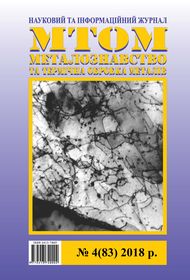Influence of processes occurring in carbon-containing environment on a solid phase autopitaxy of diamond
DOI:
https://doi.org/10.30838/J.PMHTM.2413.261218.54.566Keywords:
diamond, solid-phase auto-epitaxy, cast iron, physical fields, growth medium,Abstract
Abstract. Purpose. The purpose of this work was to analyze the effect of structural rearrangements in the metal matrix of cast iron near graphite inclusions occurring at the meso-level with the complex effect of physical fields on the formation and growth characteristics of dynamic synthesis diamond. Methodology. Synthetic cast irons with different matrix and graphite form served as materials for research. Dynamic loading is carried out by striking a metal plate accelerated by the detonation products of an explosive. Some samples were subjected to forging at a temperature of 950 °C, as well as thermal cycling at a heating rate of 150 °C/min to 900 °C, holding 20...30 min, cooling with a furnace (5 cycles). The following research methods were used: metallographic (“Neophot-21”), X-ray microscopy, scanning electron microscopy (“MS-46” and “Nanolab-7”), X-ray diffraction (DRON-UM1). Findings. The influence of deformation and heat treatments on the redistribution of defects of the crystal structure under conditions of complex action of physical fields that promote the nucleation and growth of particles during solid-phase auto-epitaxy of diamond is discussed. It is shown that austenitic gray iron with lamellar graphite is the most favorable for realization of blast diamond growth. Originality. It is shown that this process is the result of a favorable combination of a number of factors: the composition and structure of the growth medium (cast iron matrix), the carbon source (graphite), temperature and deformation fields ensuring the passage of polymorphic transformation of graphite → diamond and the appearance of gradient stress fields, as well as the redistribution of defects of crystalline structure at the mesolevel in the stages of forging, explosion and thermal cycling, which facilitates the acceleration of the delivery of carbon atoms to the growing particles of diamond and predominantly growth of diamond in the kinetic regime under conditions of its thermodynamic metastability. Practical value. Using the obtained results will allow to develop methods and modes of obtaining ultradispersed diamonds for the needs of modern technology.References
Danilenko V.V. Sintez I spekanie almaza vzrivom [Synthesis and sintering of diamond by explosion]. Moscow : Energyatom Publ., 2003, 271 p. (in Russian).
Verehchagin A.L. Svoistva detonatsionnih almazov [Properties of detonation nanodiamonds]. Biysk : Alty University Publ., 2005, 134 p. (in Russian).
Dolmatov V.Yu. Ultradispersnie almazi detonatsionnogo sinteza [Ultradispersed diamonds of detonation synthesis]. Saint-Petersburg : Politechnic University Publ., 2003, 344 p. (in Russian).
Soboliev V.V. K voprosu o crystallizatsii almaza v pripode [On the issue of crystallization of diamond in nature]. Phizika gorenia i vzriva [Physics of combustion and explosion]. Novosibirsk, 1987, no. 1, pp. 91–95. (in Russian).
Taran Yu.N., Sobolev V.V., Gubenko S.I. and Slobodskoy V.Yu. Obrazovanie almaznih vklucheniy v serom chugune pri sochetanii udarno-volnovoiy obrabotki I termotsiklirovanija [Diamond inclusions formationin gray cast iron with a combination of shock-wave processing and thermal cycling]. Metalli [Metals]. 1991, no. 3, pp. 140–147. (in Russian).
Slobodskoy V.Yu, Soboliev V.V., Hubenko S.I. and Udoiev A.A. Issledovanie svoistv ishodnoy sredi dlia cristallizatsii almaza [The study of the properties of the initial medium for the crystallization of diamond]. Metalli [Metals]. 1989, no. 6, pp.183–185.
(in Russian).
Taran Yu.N., Soboliev V.V., Hubenko S.I. and Slobodskoy V.Yu. Almaz dinamicheskogo synteza v serom chugune, virashchenniy termotsiklirovaniem [Diamond of dynamic synthesis in gray cast iron growned by thermal cycling]. Dokladi academii nauk SSSR [Reports of the USSR Academy of Sciences]. 1991, vol. 319, no. 6, pp. 1374–1377. (in Russian).
Soboliev V.V., Taran Yu.N. and Hubenko S.I. Syntez almaza v chugune [Synthesis of diamond in cast iron]. Metallovedenie i termicheskaija obrabotka metallov [Metal science and heat treatment of metals]. 1993, no. 1, pp. 2–6. (in Russian).
Belchenko G.I. and Hubenko S.I. Microneodnorodnaja deformatsia stali, soderzhashchei nemetallichskie vkluchenia [Microheterogeneous deformation of steel containing non-metallic inclusions]. Izvestija AN SSSR. Metalli [News of the USSR Academy of Sciences. Metals]. 1981, no. 4, pp. 94–97. (in Russian).
Usherenko S.M., Hubenko S.I. and Nozdrin V.F. Izmenenie strukturi zheleza I stali pri sverhglubokom vnedrenii visokoskorostnih chastits [Changes in the structure of iron and steel with ultra-deep introduction of high-speed particles]. Metalli [Metals]. 1991, no. 1, pp. 124–125. (in Russian).
Panin V.E. Volnovaja pripoda plasdtichekoj deformatsii tverdih tel [The wave nature of plastic deformation of solids]. Izvestija vuzov. Fizika [Izv. universities. Physics]. 1990, no. 2, pp.4–18. (in Russian).
Hubenko S.I. Vozmozhnosti transformatsii nemetallicheskih vkluchenij I mizhphasnih granits vcluchenie-matritsa pri visokoenegheticheskih obrabotkah [Possibilities of transformation of non-metallic inclusions and interphase inclusion-matrix boundaries under high-energy treatments]. Metallоphizika, noveishie tehnologii [Metal Physics, New Technologies]. 2014, vol. 36, no. 3, pp. 287–315. (in Russian).
Griniaev Yu.V. and Panin V.E. Raschet napriazchennogo sostoiania v uprugo nagruzhennom policristalle [Calculation of the stress state in an elastically loaded polycrystal]. Izvestija vuzov. Fizika [Izv. universities. Physics]. 1978, no. 12, pp. 95–101.
(in Russian).
Panin V.Ye., Meshcherjakov Yu.I., Yelsukova T.F. and Divakov A.K. Necryslallograficheskie structurnie urovni deformatsii v silnovozbuzhdennih sistemah [Non-crystallographic structural levels of deformation in highly excited systems]. Izvestija vuzov. Fizika [Izv. universities. Physics]. 1990, no. 2, pp.107–120. (in Russian).
Downloads
Published
Issue
Section
License
Authors that are published in this journal agree to follow the conditions:
Authors reserve the right to the authorship of his work and cede the right to the journal of first publication of this work on conditions of the license under the Creative Commons Attribution License, which allows others to distribute it freely with the obligatory reference to the author of the original work and the first publication of the work in this journal.

